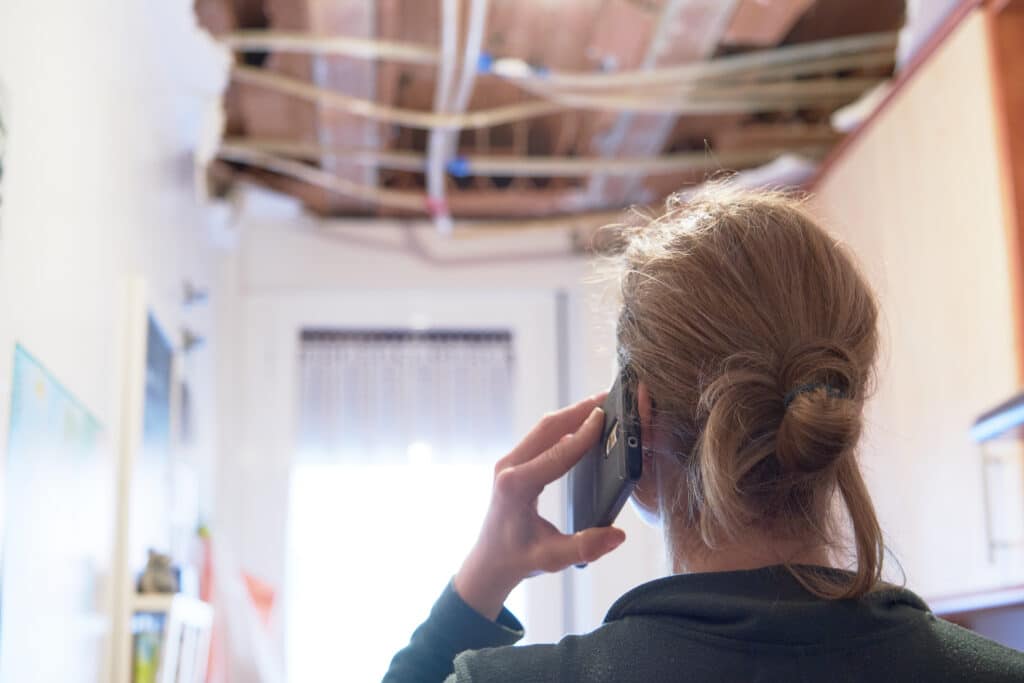
Types of Damage Covered by Homeowner’s Insurance
It’s important to remember that every insurance policy is unique so some stuff listed here might not be accurate for you. That’s why it’s important to look over your policy or talk to an insurance representative. Many of you may be wondering how to get insurance to pay for roof replacement, well, policies will have covered perils and specific perils that are excluded. Covered perils are any event that your insurance will cover. These include severe weather events such as hail, lightning, and wind damage. Covered perils will also typically include vandalism, water damage, and falling objects.
How does Homeowner’s Insurance Work?
There are two main types of coverage for roof replacement: actual cash value (ACV) and replacement cost value (RCV). Here’s a breakdown of each type:
Actual Cash Value (ACV) Coverage: This type of coverage pays the current market value of your roof minus depreciation. Depreciation is calculated based on the age and condition of your roof. So, if your roof is 10 years old and has a lifespan of 20 years, you’ll receive 50% of the total cost of a new roof.
Replacement Cost Value (RCV) Coverage: This type of coverage pays the full cost of replacing your roof, regardless of depreciation. This is the most comprehensive coverage and is typically more expensive than ACV coverage.
When you purchase homeowners insurance, it’s important to carefully review the policy to determine which type of roof replacement coverage you have.
Steps on Filing a Claim for A Roof Replacement
- Document the Damage: Take pictures of the damage to your roof and any other affected areas. This will help you provide evidence of the damage to your insurance company.
- Contact Your Insurance Company: It’s always a good idea to do this step as soon as possible. Dealing with insurance companies can be a hassle. The sooner you get started the better.
- Schedule an Inspection: Your insurance company will send an adjuster to inspect the damage and determine the cost of repairs or replacement.
- Receive a Settlement Offer: Your insurance company will provide a settlement offer based on the type of coverage you have.
- Choose a Contractor: Once you’ve received a settlement offer, you can choose a contractor to perform the repairs or replacements.
- Complete the Work: Your contractor will complete the work and invoice your insurance company for the cost.
Should I Repair or Replace my Roof?
There are a few factors that go into deciding whether or not to replace or repair your roof. One of the most important factors is going to be the roof age. If the age of the roof is reaching its final years, it’s a good idea to just fully replace it because problems will keep arising until you do. Roofs generally last 20-30 years depending on the type of roof. Another factor to consider is how much of a difference is the price of the repair and replacement. If the price is close you should just go ahead and fully replace your roof. If the damage is localized in one spot it’s a good idea to just repair it.
Ways to Maintain Your Roof to Avoid Costly Repairs
It’s important to regularly maintain your roof so you can maximize its lifespan and avoid costly repairs. Here are some simple things you can do to maximize the lifespan of your roof:
Schedule periodic inspections
It’s okay to hire an inspector every couple of years but make sure it’s a trustworthy contractor, some contractors will say your roof has a problem just to get you to replace your roof. It’s also a good idea to schedule an inspection if you notice any leaks or if any large branches fall onto your roof.
Cut Overhanging Branches
If you notice any branches hanging over your roof, it’s a good idea to cut them as soon as possible. During storms, branches can easily fall off onto your roof and cause damage.
Keep Gutters Clean
Water needs a clear path to fall from your roof, so if your gutters are clogged that water will get stuck and can cause leaks and weaken the structure of your roof. If you notice your gutters look cluttered it’s a good idea to get up there and clean them out.
Homeowner’s Insurance Coverage
A roof is one of the biggest expenses you face as a homeowner that’s why it’s important to properly maintain it and have homeowner’s insurance. Make sure to fully read over your insurance policy to understand what perils are covered. Your roof is what keeps you and your family safe during harsh weather events so it’s important to stay on top of inspections and replace it when it starts reaching the end of its lifespan. If you’re in The State of Florida and you’re looking to replace your roof soon feel free to contact us for a free quote. If you’re looking for a quick roof quote feel free to use the tool below for an estimate. The quote is subject to change and is just a preliminary estimate.